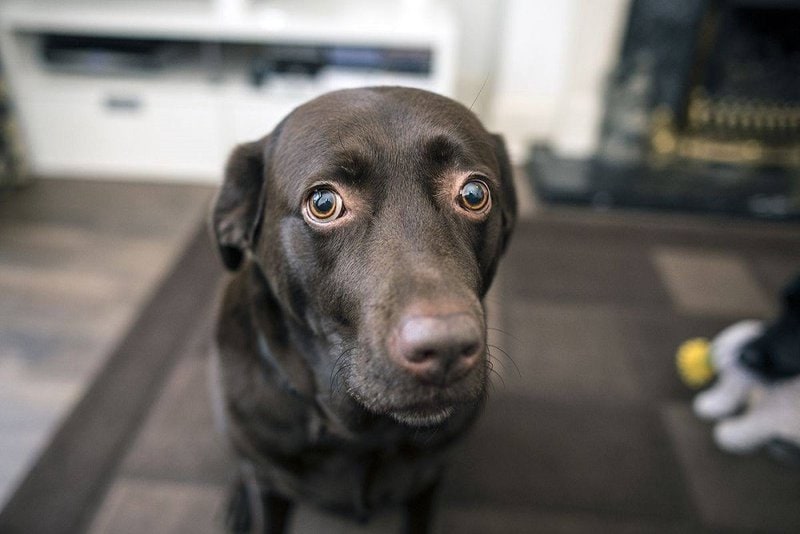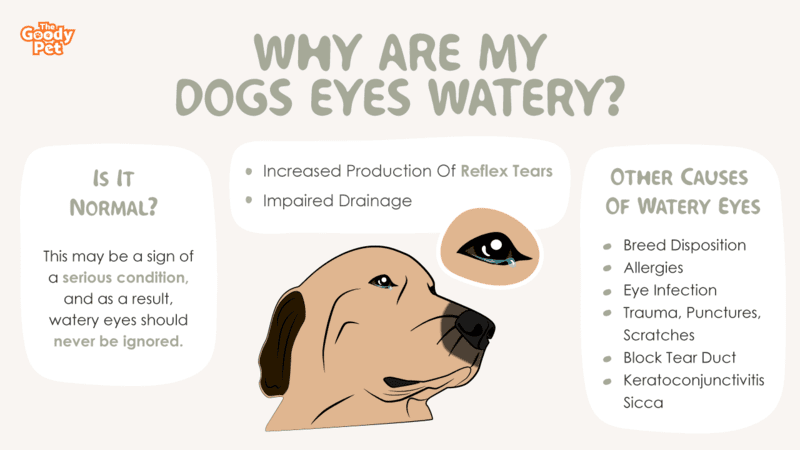Have you noticed your dog has watery eyes and wondered why that happens? Watery eyes are a common problem in dogs. Although some kinds of watery eyes are completely normal, others are caused by serious health concerns. So, what are the causes of watery eyes in dogs?
Causes of watery eyes can range from something simple as dirt or wind to severe health conditions like glaucoma. However, the two primary reasons why dogs may have watery eyes are increased production of reflex tears and impaired drainage leading to an overflow of tears. In most cases, dogs need some human intervention or prompt medical attention.
Treating watery eyes is dependent on the leading cause of it. For instance, duct obstruction, abnormal eyelashes, or ulcers may require surgery, while cornea damage may be treated by topical medication or antibiotics. Keep reading this post to find out all you need to know about watery eyes in dogs.
Why Are My Dogs Eyes Watery?

When a dog’s eyes are teary or draining, it is usually a sign of eye issues most of the time. Most often than not, it is easy to tell when your dogs are too watery, or there is a discharge.
There are some possible causes for watery eyes in dogs. But first, let’s understand what we mean when we say watery eyes.
What Are Watery Eyes?
Watery eyes, also known as ocular discharge, and with the medical term, epiphora, is excessive tearing that is often caused by a number of conditions. This could be infections, abnormalities of the eyelids, or sometimes diseases of the eye.
Any eye condition can be painful to your dog. Watery eyes become a problem when accompanied by other symptoms like irritation. Resolution of this condition may involve either simple or complex interventions depending on the cause.
While watery eyes are not really bred specific, there are some breeds that are more predisposed to some eye conditions. For instance, dogs with squished or anatomically flattened faces will often have problems with tear duct drainage.
Is It Normal For Dogs’ Eyes To Have Water?
While watery eyes are a common issue in dogs, it’s not normal in most instances. Instead, the excessive tearing or epiphora may develop into a discharge that is either white, yellow, green, or green in color.
This may be a sign of a serious condition, and as a result, watery eyes should never be ignored.
What Causes Watery Eyes In Dogs?

As mentioned, there is a wide range of causes for watery eyes that have different degrees of seriousness. However, here are some common causes of watery eyes.
Breed Disposition
Some dog breeds are more predisposed to watery eyes than others. For example, brachycephalic dog breeds, such as Bulldogs, Shih Tzus, Cocker Spaniels, and Pugs, are more susceptible to eye discharges because of the shapes of their face.
In addition, smaller dog breeds might also be more disposed to watery eyes in comparison to larger dogs. Also, for some breeds, moisture can collect in the nasal and facial skin folds of breeds, and this provides an ideal environment for bacterial growth.
In turn, this causes infections, especially if the area is not always kept dry and clean. Furthermore, breeds with excessive hair on their face may experience hair growing towards the eye leading to watery eyes.
Allergies
Suppose your dog has food or environmental allergies; Once they are exposed to its allergens, chances are its eyes will become red and weepy.
This is compared to the same way hay fever affects humans. In addition, a vet may administer some antihistamine medications to help eliminate watery eyes caused by allergies.
Eye Infections
Dogs can get fungal, bacterial, or viral infections in their eyes. This can simply be caused by an irritant that got into the eye. These infections may also be transmitted from one animal to another.
However, once the eye infection is present, your dog may need proper prescription medications. This may involve applying eye drops or ointment to the eyes several times a day.
Trauma, Punctures, Scratches
Minor irritants and allergens may make a dog’s eyes watery, and further rubbing its eyes may lead to inflammation and irritation.
Some serious eye injuries may also happen if the dog’s eye is scratched by something sharp such as an object or other animals. Therefore, if you think your dog has an eye injury, ensure you take your pooch to your vet for a checkup.
Blocked Tear Duct
The nasolacrimal duct will drain tears through the nose and from the eyes. However, a blocked nasolacrimal duct may cause normal tears to overflow in the eyes, causing watery eyes.
Keratoconjunctivitis Sicca
Keratoconjunctivitis Sicca, also called dry eye, is a condition that involves the underproduction of tears. Due to the lack of enough lubrication, this condition may cause some irritation to the eye.
In addition, very dry eyes can cause a sticky discharge, visual issues, pain, thickness, and infections. Visiting the vet is necessary for this condition to be treated properly.
What Types Of Conditions Can Cause Watery Eyes?

Health conditions are another common cause of watery eyes. Here are some common conditions that can lead to watery eyes.
Distichiasis
With this condition, the eyelashes grow in an abnormal direction and location. This abnormal growth of eyelashes can affect the entire row of eyelashes. In addition, since the hairs grow towards the eye and along the eyelid, it may cause some serious irritation.
Genetics is a factor when it comes to this condition. A lot of dog breeds are prone to this condition, including Golden Retriever, Boston Terrier, American Cocker Spaniel, Bulldog, Chesapeake Retriever, Cavalier King Charles Spaniel, Shih Tzu, and Pug.
Entropion
The entropion condition causes the eyelid to roll inwards, and as a result, the eyelashes on the eyelid’s surface will rub against the cornea. This leads to irritation and, later on, watery eyes.
Like Distichiasis, some breeds are also prone to this condition, including Labrador Retriever, Saint Bernard, Great Dane, Irish Setter, American Staffordshire Terrier, Shih Tzu, Japanese Chin, Basset Hound, Shar Pei, Bulldog, Pekingese, Siberian Husky, Podles, Mastiff, Akita, and Great Pyrenees.
Conjunctivitis
Conjunctivitis is an inflammation issue on the lining tissue which covers the eyes. Most often than not, both eyes are involved and may either be breed-specific viral, bacterial, or allergic. It may also be caused by another disease.
Some breeds that are more predisposed to this condition include Collies and German Shepherds.
Dacryocystitis
This condition involves an inflammation of the tear duct that can either be acquired through a bacteria and tumor or genetic through abnormal development.
Due to their tight eyelids and shallow eye sockets, brachycephalic breeds are more prone to this condition. They have a wide and flat skull, and some common examples are Boston Terrier, Pug, Pekingese, and Bulldog.
Corneal Ulcer
A corneal ulcer is simply the erosion through the outer layer of the eye (epithelium) into the main tissue of the cornea (stroma). Mostly, this condition is caused by trauma and infections but can also be caused by other conditions like epithelial dystrophy or dry eyes.
It can be very destructive to the eyes. Without treatment, it may even result in loss of vision or the eye itself.
Glaucoma
Glaucoma can be seen in a variety of ways, including cloudy eyes, bulging eyes, or teary eyes. It is mainly caused by excessive pressure in the eye that leads to lots of pain.
With proper medications and treatment, the vet may try to manage this pressure. However, in some serious cases, surgery may be required.
What Are The Main Symptoms Of Watery Eyes In Dogs?
Eye conditions can be extremely uncomfortable for a dog, and veterinarian treatment is required. Here are some symptoms you should look out for when it comes to watery eyes.
- Discharges
- Sneezing
- Odor
- Itchiness around the eye
- Redness of the eye
- Wetness or dampness under the eye
- Puffiness in the eye
- Reddish-brown stains on their fur near the eyes
- Rubbing of eyes
- Squinting or twitching is a sign of pain
- Keeping their eyes shut
- Troubles with vision
- Glassy appearance on the eyes
- Bloody or red appearance to the whites of eyes
What Should I Do If My Dog Has Watery Eyes?
Once you notice any of the above symptoms of watery eyes, it is always a great idea to visit the vet. The vet will assess the symptoms and know how to go about the treatment.

Can Watery Eyes Be Treated?
Yes. Any professional vet should be able to treat watery eyes through medication or surgery.
Here is the procedure that your vet may follow.
Diagnosis
Watery eyes may be a sign of a serious condition, so you should never delay visiting your vet for treatment. The first thing any vet will want to know is how long the eyes have been watering or whether there is another illness that may be associated with watery eyes.
However, if your dog is experiencing signs of pain, a topical anesthetic may be administered to the dog’s eye before diagnosis and examination start to ensure the surface is numb.
Vets may also apply a fluorescein stain to the eye for a painless procedure to check for scratches and foreign objects as well as assess tear drainage. Your dog’s head will be tilted downward once the stain is applied to check the drainage abilities of the nose.
Normally, the stain should be seen in the nose within a few minutes. The veterinarian should also do a Schirmer Tear Test to evaluate tear production in your dog’s eyes as well as nasolacrimal duct function and corneal damage.
Radiographs may also be used to check for possible obstructions. Furthermore, your vet may suggest a visit to the ophthalmologist, depending on the main cause of the epiphora.

Treatment
When it comes to the treatment of watery eyes in dogs, the method varies depending on the cause. For instance, entropion and distichiasis conditions may require surgery.
This is because the hair and eyelashes on the eyelids may rub against the eyeball, resulting in ulcers, which, when left untreated, can cause vision loss.
In the case of conjunctivitis, treatment may involve flushing the eye and maybe antibiotic therapy. Eye ointments and drops are also administered.
For dacryocystitis, treatment may involve flushing the eye with saline or water solution. Antibiotics may be prescribed maybe, but if the damage is too severe, then surgery may be required to create a drainage pathway to empty tears to the nasal cavity, sinus, or mouth.
If their corneal ulcer is present, it is crucial to take care of them as fast as possible since it can damage the eye beyond repair. Ointments and antibiotic eye drops may be needed. Atropine can also be used to relieve pain.
However, there is a chance that the dog will need to wear an Elizabethan collar to ensure it doesn’t rub an eye.
Recovery
In the case of watery eyes or epiphora, return visits may be required to resolve the problems completely. However, recurrent episodes of watery eyes are common, even if you feel that your dog is completely healed.
The vet may need to confirm that the therapy has worked sufficiently. Sometimes, multiple flushings may be required. Also, you may be required to administer ointment or eye drops for an extended period. You may also need proper grooming to prevent a recurrence.
How To Prevent Excessive Watery Eyes
If your dog doesn’t have any other underlying issues, there is a good chance that you can prevent watery eyes using the following procedures.
- Visit your veterinarian regularly for your dog’s health checkup.
- Gentle drying and daily washing of the area around your dog’s eyes may help prevent any irritation.
- You can use over-the-counter optical grade eye irrigation solutions that are safe for the dogs to ensure the area under the eyes remains clean and odor-free.
- Ensure the hair under your dog’s eyes is as short as possible. Visiting a groomer to have the hair trimmed is the best idea.





